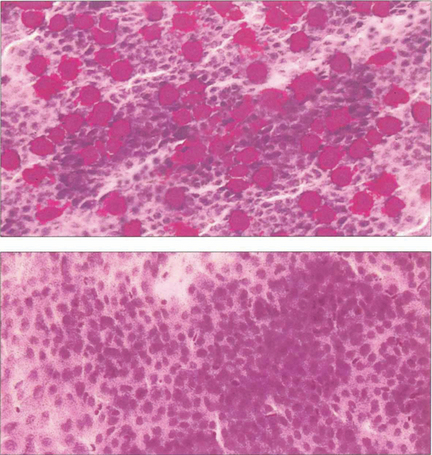3 The Conjunctiva: Diseases and Tumours
The conjunctiva is the transparent mucous membrane lining the inner surfaces of the eyelids; it is reflected over the anterior episclera and sclera before terminating at the limbus, where it is continuous with the corneal epithelium. In the embryo the conjunctiva develops from the ectoderm covering the lids and surface of the globe, and is formed during the third month of intrauterine life as the eyelids grow together. A healthy conjunctiva is essential for normal ocular function and together with the eyelids it is critical in maintaining a suitable environment for the cornea to function as the primary refractive element of the eye. Its mucous and accessory lacrimal secretions are important components of the precorneal tear film, and their deficiency gives rise to tear film instability and poor wetting of the corneal surface, which may lead eventually to pathological changes in the cornea. It follows, therefore, that examination of the whole conjunctival surface is necessary in order to interpret signs in the cornea, and an understanding of conjunctival pathology is a prerequisite to the effective management of many corneal disorders. As part of its function in maintaining the corneal environment, the conjunctiva also has an important role in defending the eye against a variety of agents.
THE NORMAL CONJUNCTIVA

Fig. 3.1 The conjunctiva is comprised of a bulbar portion covering the anterior part of the globe (except for the cornea) and two palpebral portions that cover the posterior aspects of the upper and lower eyelids. The palpebral and bulbar conjunctiva are continuous through the upper and lower fornices. The blood supply of the conjunctiva is derived mainly from that of the eyelids, with some contribution from the anterior ciliary vessels in its bulbar portion through the limbal plexus. The nerve supply is mainly from the ophthalmic division of the trigeminal nerve but a variable proportion of the inferior conjunctiva is supplied by branches of the maxillary division.

Fig. 3.2 The bulbar conjunctiva is normally transparent making the subconjunctival and episcleral blood vessels easily visible. Its anterior limit is the limbus where the epithelium becomes continuous with that of the cornea. The normal limbal arcade of blood vessels (formed by anastomosis of the terminal branches of the posterior conjunctival and anterior ciliary vessels) may extend a short distance on to the cornea but in so doing terminates in an even border on the clear cornea.

Fig. 3.3 The lower palpebral conjunctiva may be readily inspected by gentle downward traction on the lower eyelid. It is slightly thicker than the bulbar conjunctiva and is highly vascular, especially in its tarsal portion where it derives its blood supply from the tarsal arcades. The lower fornix itself has few blood vessels but a larger amount of lymphoid tissue and mucus-secreting glands.

Fig. 3.4 The upper tarsal conjunctiva is inspected by everting the upper eyelid. As in the lower lid, it is firmly adherent to the underlying tarsal plate. The blood supply is derived from the palpebral arcades, of which the branches are readily visible. A small number of lymphoid follicles can often be seen at the medial and lateral aspects of its upper border.

Fig. 3.5 The upper fornix is visible only on double eversion of the upper eyelids using Desmarres’ retractor. Here the posterior conjunctival vessels are visible and interspersed with yellowish patches of inactive lymphoid tissue. It is particularly important to examine the upper fornix when searching for foreign bodies or in cases of suspected chlamydial conjunctivitis when enlarged follicles are seen (see Ch. 4).
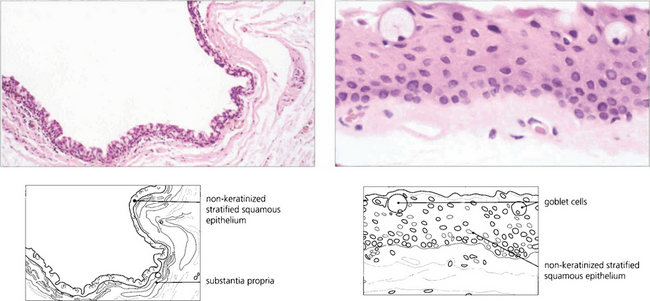
Fig. 3.6 The microscopic anatomy of the conjunctiva shows it to consist of non-keratinized squamous epithelium overlying a substantia propria. In its tarsal portion, the connective tissue elements of the latter form a fine network creating a papillary structure, but towards the fornices it is looser and contains elastic fibres, blood vessels and lymphoid tissue. In addition, the conjunctiva contains numerous goblet (mucus-secreting) cells, especially in the fornices, and the accessory (lacrimal) glands of Krause and Wolfring.
PATHOLOGICAL CHANGES OF THE CONJUNCTIVA
Causes of papillary and follicular conjunctivitis are listed in Table 3.1.
| Papillae | Follicles |
|---|---|
| Allergic conjunctivitis; atopic, vernal, seasonal or perennial | Virus infection: adenovirus, herpes simplex, molluscum contagiosum |
| Topical preparations: drops, preservatives, ointments | Cnlamydial infection: trachoma (subtypes A–D), paratrachoma (subtypes E–K) |
| Chronic 1irritation: giant papillary conjunctivitis, superior limbic conjunctivitis, dry eyes | Drug induced: glaucoma, antiviral drops |
| Lymphoid disease: reactive hyperplasia, conjunctival lymphoma |
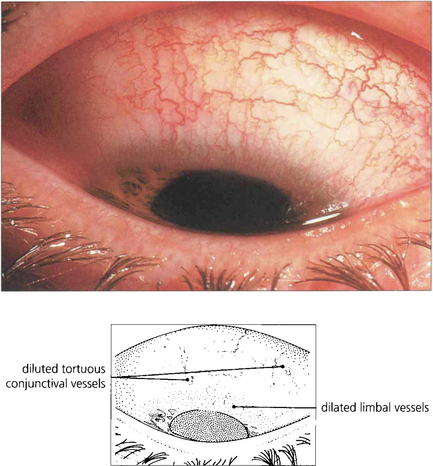
Fig. 3.9 Hyperaemia of the conjunctiva may occur as part of any acute inflammatory process or in response to chronic irritative factors. There is an increase in the number, calibre and tortuosity of the vessels, producing a characteristic bright red appearance. Hyperaemia is often associated with increased vascular permeability and oedema or cellular infiltration.

Fig. 3.10 Avascularity of the conjunctiva occurs as a result of vascular endothelial damage to the conjunctival vessels from toxic or chemical insult. The affected conjunctiva is blanched. Depending on the degree of penetration of the chemical agent, the episcleral and scleral vessels may be spared, as in this example. Such changes are most commonly seen acutely following alkali burns but may also follow subconjunctival antibiotic injections or prolonged use of topical antiviral preparations, as in this case, resulting from trifluorothymidine administration, an antiviral agent once used to treat herpes simplex keratitis.
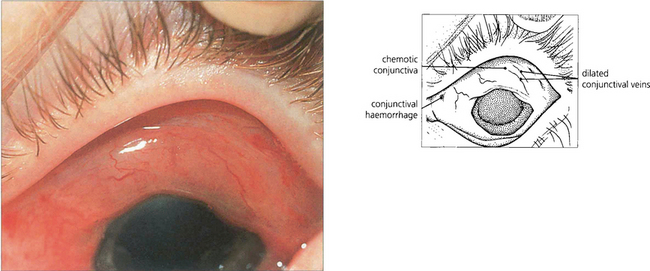
Fig. 3.11 Congestion of the conjunctival vessels arises as a result of impaired venous drainage or increased permeability which, if severe, may produce oedema of the conjunctiva (chemosis). The characteristic dusky red coloration results from increased vascular stasis within the conjunctiva. Chemosis without venous congestion occurs most commonly in association with acute allergic states when the pale swollen conjunctiva takes on a jelly-like appearance (see Fig. 5.2).
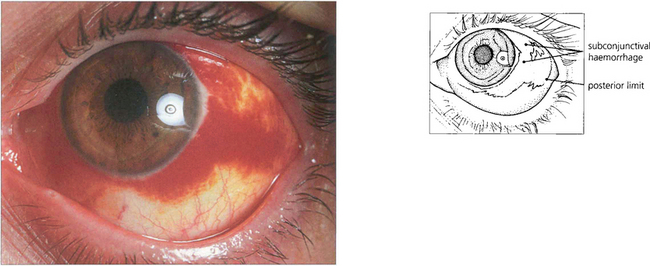
Fig. 3.12 Subconjunctival haemorrhages most frequently arise spontaneously and appear as red patches extending to the limbus. They may result from an episode of raised venous pressure (e.g. following coughing) or from trauma and very rarely from blood dyscrasias or vessel anomalies. With head trauma, if no posterior limit to the haemorrhage is defined, the blood may have resulted from a middle or anterior cranial fossa fracture and patients should be examined with this in mind.

Fig. 3.13 Papillary hypertrophy is caused by the conjunctiva being thrown into folds and characterizes the subacute stage of many types of inflammation. Basically, the papillae represent a vascular response with an exaggeration of some aspects of the normal conjunctival anatomy. Clinically they can be recognized as small elevations of the conjunctiva that produce a slightly granular or velvety appearance. They break up the smooth glistening light reflex of normal conjunctiva. In this example, the minute surface irregularity produced by the individual papillae are highlighted in the light reflex laterally. Each papilla contains a central dilated arteriole with a surrounding clear or slightly infiltrated zone of swollen conjunctiva. Usually, papillae can be seen only on biomicroscopic examination, but in some chronic conditions giant papillae may form that can be seen with the naked eye.

Fig. 3.14 Histologically, the conjunctiva between individual papillae is tethered to the underlying tarsal plate by the fibrous network normally present in the substantia propria, and the papillae are produced by oedema, cellular infiltration and vasodilatation within the spaces of this meshwork. Many chronic inflammatory cells are present.
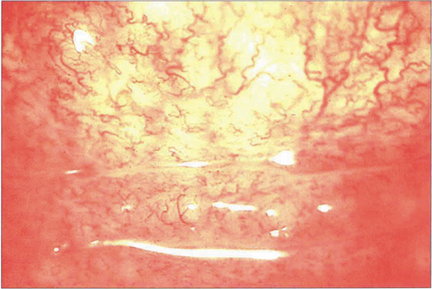
Fig. 3.15 The clinical appearance of follicles is of large pink or pale grey elevations lying beneath the conjunctival epithelium with small blood vessels frequently visible on their surface. In the early stages, they are present only in the fornices but may extend on to the tarsi if the disease becomes chronic. Follicles are associated particularly with conditions in which cell-mediated immune mechanisms are involved, such as viral infections and drug hypersensitivity. They can be seen in normal conjunctiva in childhood.

Fig. 3.16 Conjunctival follicles are collections of lymphoid germinal follicles in the subepithelial stroma with immature cells centrally and mature cells peripherally.

Fig. 3.17 Pseudomembrane formation on the surface of the conjunctiva is seen in patients with severe acute conjunctivitis. A coagulum of fibrin and proteinaceous exudate forms, and is initially loosely adherent to the underlying tissues from which the pseudomembrane may be separated without causing bleeding from the surface. A true membrane is firmly adherent to the conjunctival epithelium and attempted removal gives rise to a bleeding conjunctival surface. Subsequent organization of the membrane produces scar tissue.

Fig. 3.18 Conjunctival scarring may be the end-result of a wide variety of inflammatory processes. Its effects on the eye vary from insignificant to devastating, depending on its effects on the tear film and lid architecture. Subepithelial fibrosis is seen as white tissue, usually with associated distortion of the overlying superficial blood vessels. Localized superficial linear scarring may have little clinical significance, as in this example, which followed a severe viral conjunctivitis.


